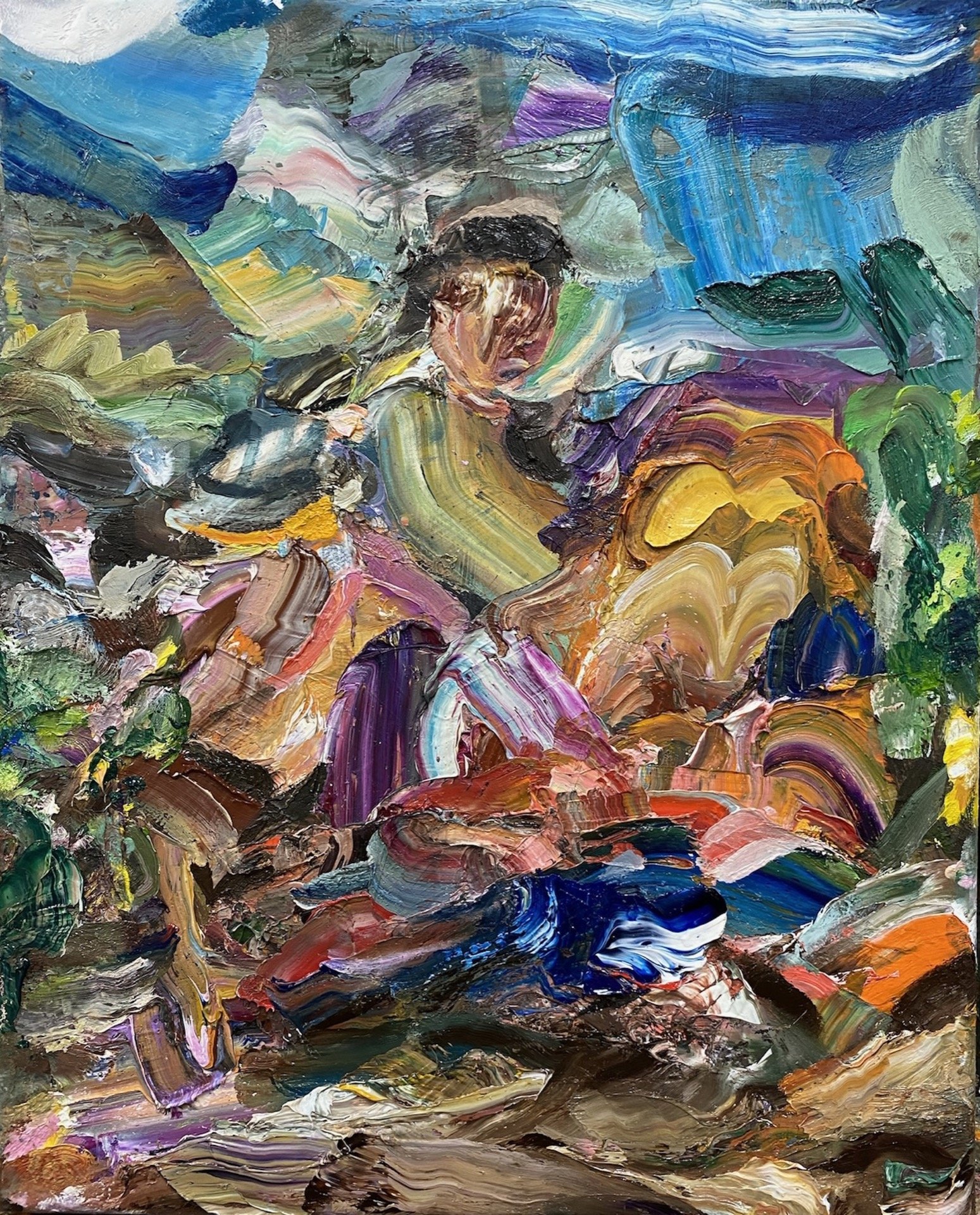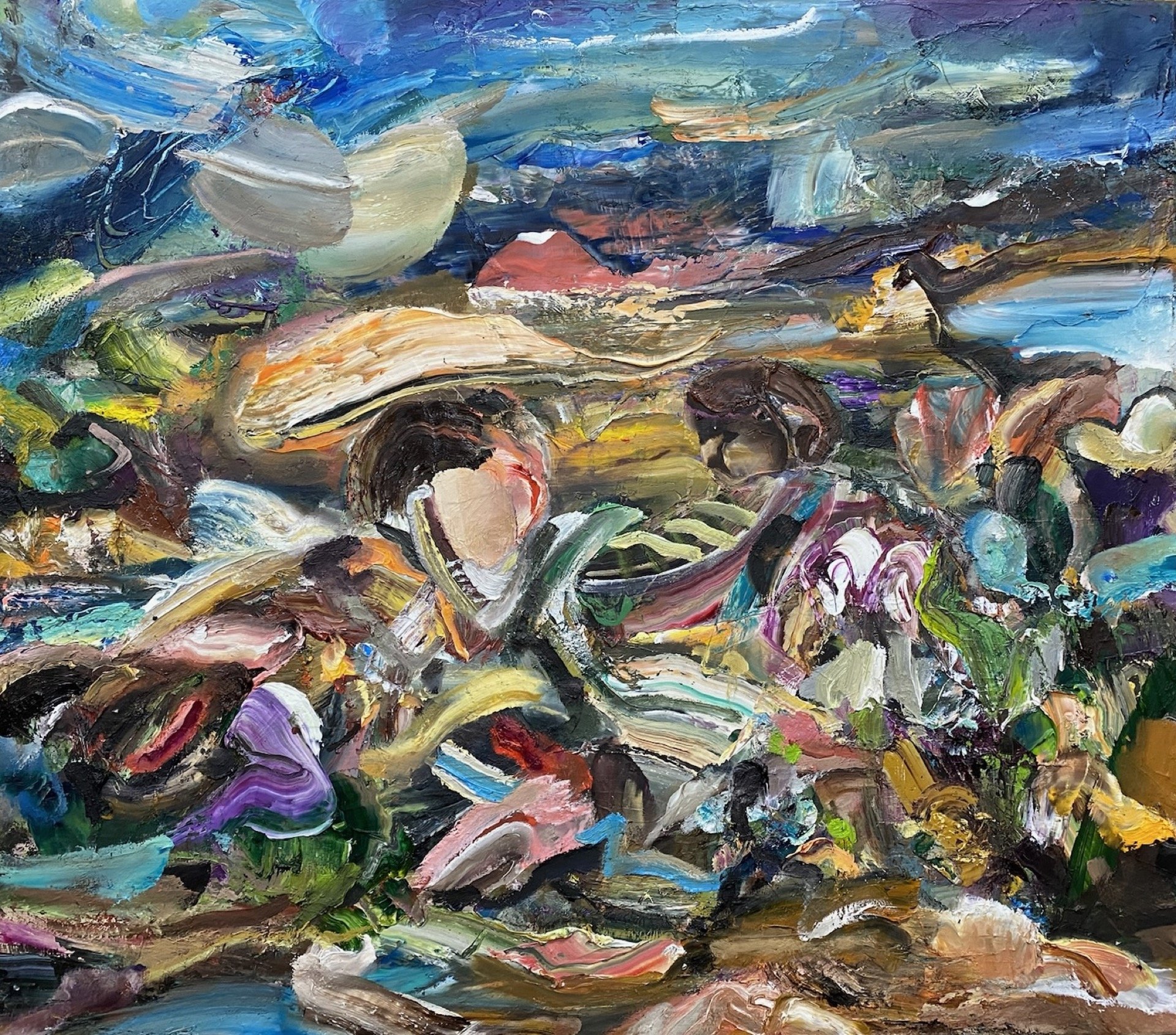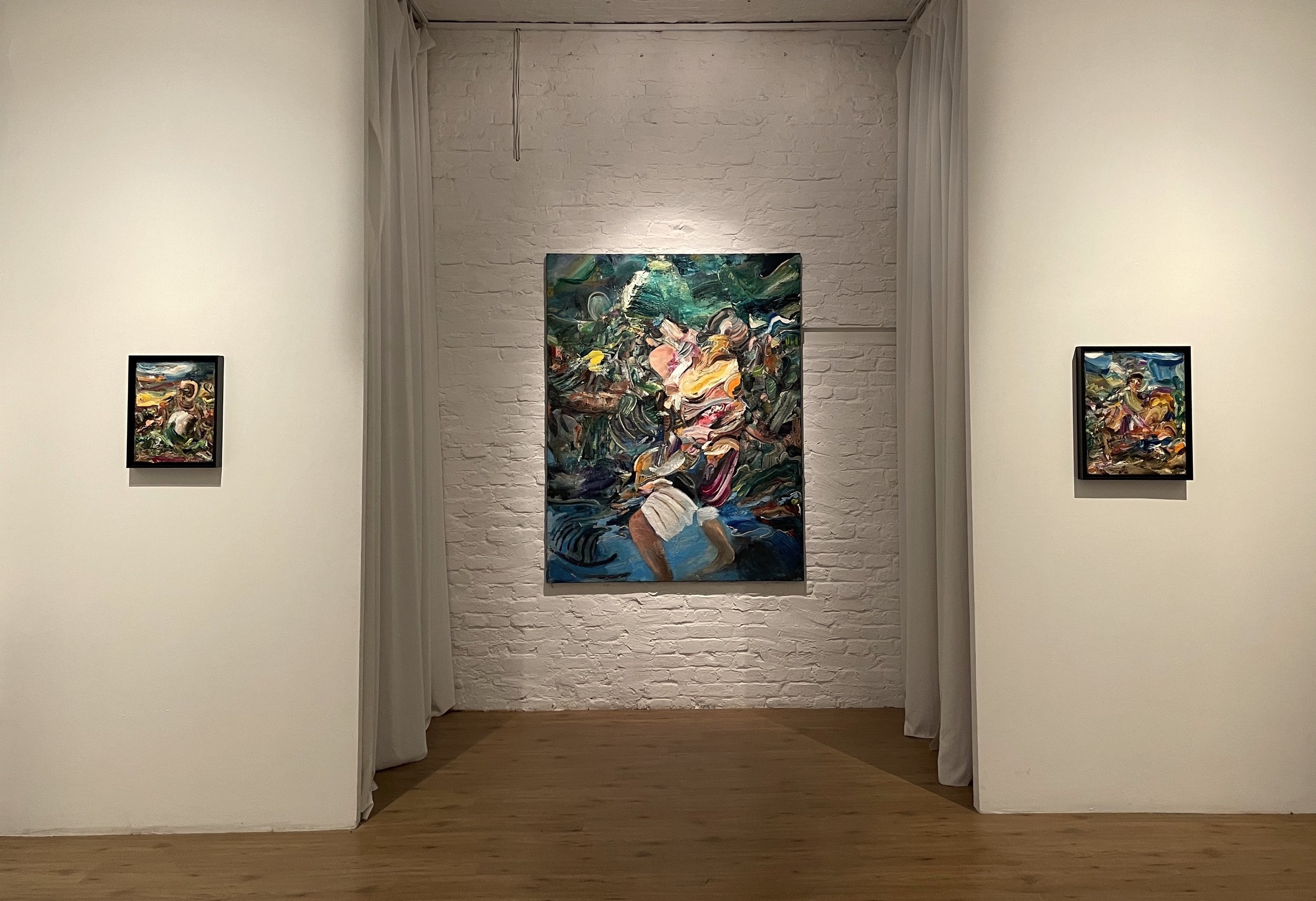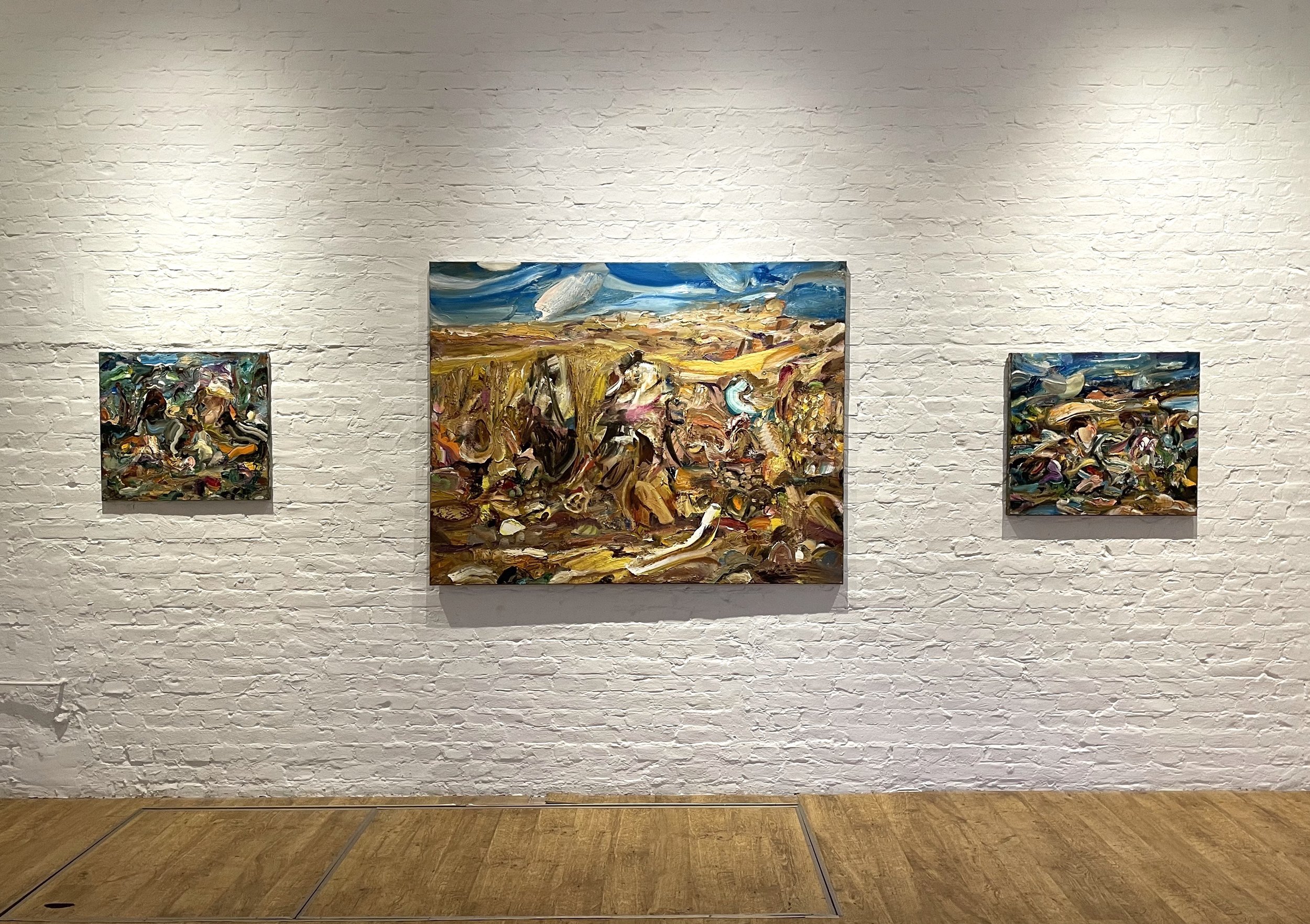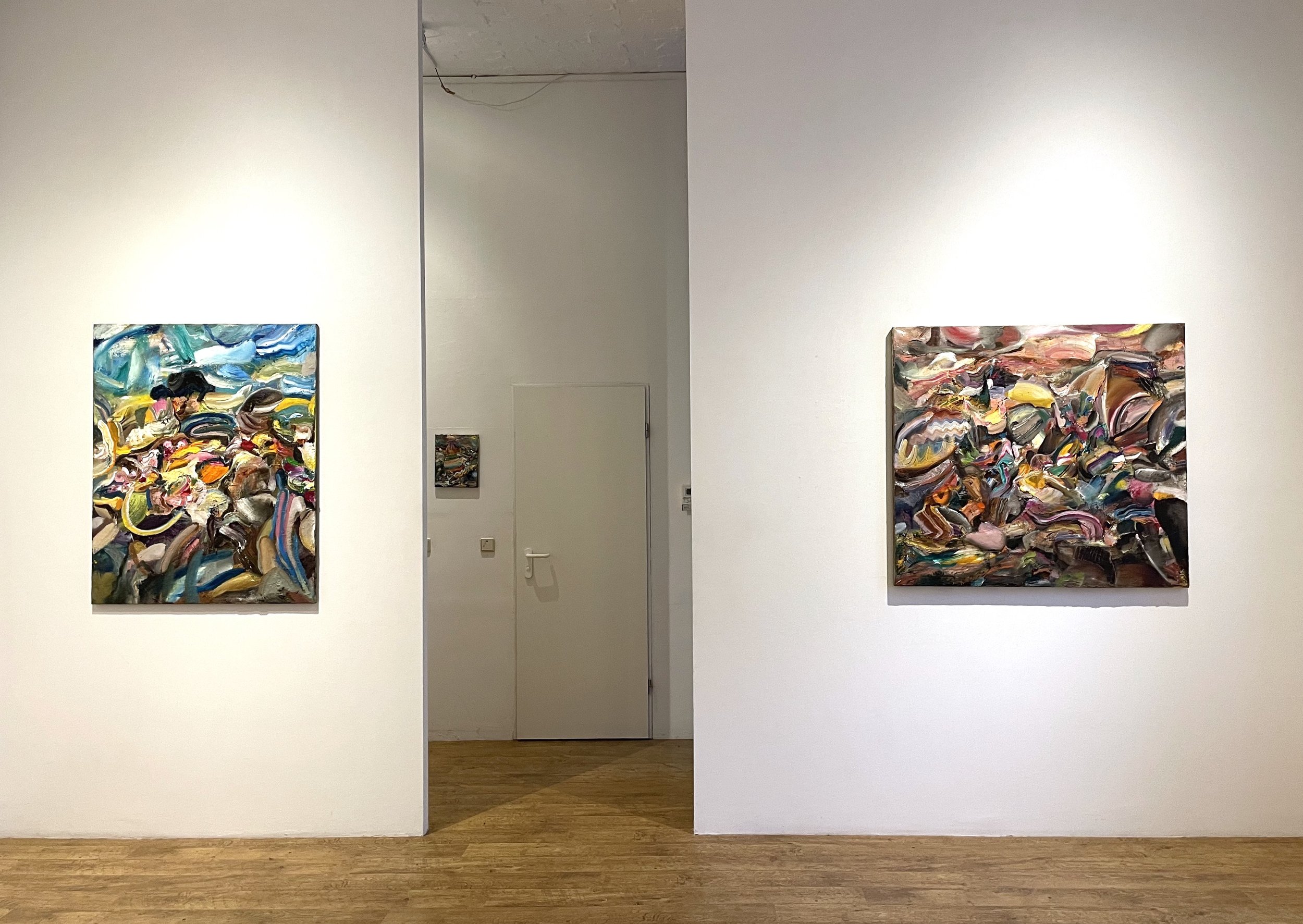STEFANO BOSIS
TRAVELING THROUGH
Vernissage, Wednesday, November 16th, 6-10 pm
Exhibition continues November 17 - December 14th
by appointment
Catalogue with text by Christoph Tannert
“The intensity of his excesses of color at times reaches the energy level of lightning and thunder.”
Christoph Tannert
„Die Welt braucht starke Gefühle und mehr Jazz“ (1)
Über die malerischen Soundteppiche von Stefano Bosis
Christoph Tannert, English below,
Stefano Bosis, Riding a lion in the forest of irremediably, 2022, Oil on canvas, 40 x 30 cm
Stefano Bosis, She was hiding in the forest, 2021-22, Oil on canvas, 180 x 140 cm
Die in den Jahren 2021/22 in Öl auf Leinwand entstandenen Bilder des in Berlin lebenden Italieners Stefano Bosis überfallen ihr furchtloses Publikum wie ein aus mehreren Lebewesen zusammengewachsenes Fabeltier. Was der Künstler etwa in „She was hiding in the forest“, „The breath“, „The time when all was near“ oder „The wolf“ anbietet, ist das ultimative Freispiel eines Bildsüchtigen, der seinen ultimativen Weg der Selbstbefreiung eingeschlagen hat, auf dem er endgültig Abschied nimmt von der Figürlichkeit.
Bereits seit 2020 befindet er sich in einem Prozess der Verwandlung weg von der identifizierbaren Figur, hin zur puren Farbe.
Stefano Bosis sieht sich auf einer spirituellen Reise hin zum Verständnis dessen, was Menschsein ausmacht, zwischen Hölle und Paradies, die eigene Vergänglichkeit vor Augen „Riding a lion in the forest of the irremediably“).
Identität ist für ihn ein Prozess ständiger Veränderung. „Wir sind der Weg, den wir gehen“, sagt Bosis im Gespräch (2) und hofft sich auf den Wellen tiefer Gefühle dann gefunden zu haben, wenn es ihm gelingt, wie in einer Energieübertragung emotional komplett im Bilde zu sein. Dazu gehört auch die Konfrontation mit den eigenen Ängsten.
Bosis lässt sich im freien Strom seiner Inspiration davontragen, er erfindet Schöpfungen radikalen Künstlertums aus dem Kampf gegen die eigenen Dämonen – face your fear … hypnotize yourself – , ohne jemals das thematische Ufer aus dem Auge zu verlieren.
Es ist weniger das fertige Bild, das er vorausschaut, vielmehr sind es die Wellenbewegungen des Malflusses, denen er sich aussetzt. Stefano Bosis lässt sich vom Bild bewusst in einen Prozess hineinziehen, den er nicht vollständig steuern kann und auch nicht will.
In gewisser Weise malen sich seine Bilder selbst.
Intuitiv ergreift Bosis jede sich ihm bietende Gelegenheit, sich der Macht des Bildentstehungsprozesses anzudienen, sich zu überantworten. Vielleicht ist ja das Bild stärker als der Künstler? Wer weiß. Sich dem Unerprobten auszuliefern, kann eine erfrischende Erfahrung sein.
Stefano Bosis ist ein Musikliebhaber. Sound und Rhythmus animieren und tragen ihn zugleich. Ein Bild wie „The musician walking” kann insofern durchaus als Hommage an Heroen wie Miles Davis, Ludovico Ennaudi oder Demetrios Stratos verstanden werden.
Dramaturgische Rezepte oder psychologisch-manipulative Logiken für den Konfliktaufbau im Bild braucht Bosis nicht. Mit seiner gelassenen Selbstverständlichkeit und seiner Neugier bilden sich immer wieder ungeahnte Möglichkeiten des Farbverlaufs.
Stefano Bosis, The wolf, 2022, Oil on canvas, 120 x 95 cm
Stefano Bosis, The right of passage, 2022, Oil on canvas, 140 x 100 cm
Stefano Bosis, The musician walking, 2022, Oil on canvas, 120 x 120 cm
Dieser Maler, der angibt, wegen der Bilder des ostdeutschen Farbfeuerwerkers Bernhard Heisig in Deutschland hängengeblieben zu sein, ist ein Spezialist für das Wirklichkeitspotential der Farbe. Er treibt Farbe in Ausnahmezustände. So entstehen ästhetische Raritäten.Die Intensität seiner Farbausschweifungen erreicht zuweilen das Energielevel von Blitz und Donnergrollen.Manches wirkt gleichermaßen kosmisch wie urban, wie ein Sog, der uns durch den Traum einer magnetischen Wellen-Utopie zieht.Die ohnehin sehr zugänglichen dynamischen Pinselführungen entwickeln sich von Bild zu Bild mal in Richtung des Geschmeidigen, mal mehr in Richtung eines Stimmungsaufbaus, mal mehr in Richtung einer bewussten Akzentuierung.
Die Malerei von Stefano Bosis dürfte in Deutschland, dem Land der Expressionisten, polarisieren. Es gibt Werke von ihm, in denen hat der Künstler die Langsamkeit entdeckt, so tiefenentspannt kräuseln sich die Spuren seiner Achtsamkeitsübungen. Doch das ist spätestens vergessen, wenn einem das abgedrehte „Shaman of Oporapa“ (zurückgehend auf Erlebnisse in Kolumbien) ein Schleudertrauma verpasst. Scheren im Kopf gibt es bei Bosis nicht. Im Wechselmodus von Flanieren und Unter-Strom-Stehen erweitert er seinen Bilderfundus. Stefano Bosis ist Kraftmensch und Sensualist. Im Klimawechsel ist er mit sich identisch. Geläufiges und Befremdliches, Freispiel und atmosphärische Bindung umkreisen sich in Unermüdlichkeit.
Stefano Bosis, Bonjour Monsieur Courbet, 2021-22, Oil on canvas, 180 x 140 cm
Stefano Bosis, Settling into my desert, 2022, Oil on canvas, 155 x 100 cm
Stefano Bosis, The time when all was near, 2022, Oil on canvas, 70 x 80 cm
Stefano Bosis, You and me, 2022, Oil on canvas, 72 x 64 cm
"The world needs strong feelings and more jazz" (1)
About Stefano Bosis' picturesque carpets of sound, Christoph Tannert
The paintings by Berlin-based Italian Stefano Bosis, created in 2021/22 in oil on canvas, attack their fearless audience like a mythical animal that has grown together from several living beings. What the artist offers in "She was hiding in the forest", "The breath", "The time when all was near" or "The wolf" is the ultimate free game of a person addicted to imagery who has embarked on his complete and utter path of self- liberation, on which he finally bids farewell to figuration.
Since 2020 he processes the transformation away from the identifiable figure towards pure color.
Stefano Bosis finds himself on a spiritual journey towards an understanding of what it means to be human, between hell and paradise, with his own transience in mind (“Riding a lion in the forest of the irremediably”). For him identity is a process of constant change. "We are the way that we go," says Bosis in conversation (2) and hopes to discover himself on the waves of deep feelings, when he succeeds in being emotionally completely present, as in an energy transmission. This also includes confronting his fears.
The free stream of Bosis´ inspiration carries him away, creations of radical artistry emerge from fighting his demons - face your fear ... hypnotize yourself - without ever losing sight of the thematic shore.
It is less the finished picture that he anticipates, he rather exposes himself to the undulations of the painting flow. Stefano Bosis is consciously drawn into a process he neither can nor wants to fully control. In a way, his paintings paint themselves. Bosis intuitively surrenders to the power of the picture-making process whenever he can. Perhaps the picture is stronger than the artist? Who knows. Surrendering to the untried can be a refreshing experience.
Stefano Bosis is a music lover. Sound and rhythm equally animate and sustain him. Paintings like "The musician walking" can be understood as a homage to heroes like Miles Davis, Ludovico Ennaudi or Demetrios Stratos. Bosis´ painted construction of conflicts does not acquire dramaturgical instructions or psychologically manipulative logics. His relaxed naturalness and his curiosity keep forming undreamt-of possibilities of the color gradient.
Bosis is a specialist in the reality potential of color, just like East German firework-like painter Bernhard Heisig, for whose work Bosis claims he stayed in Germany. He drives color into states of emergency. This is how aesthetic rarities are created.
The intensity of his color excesses at times reaches the energy level of lightning and thunder. Some things seem equally cosmic and urban, like a pull dragging us into the dream of a magnetic wave-utopia.
The very accessible dynamic brushwork changes from painting to painting, leaning at times towards suppleness or building up moods, at times more towards conscious accentuation.
In Germany, the land of the Expressionists, Stefano Bosis' paintings are likely to polarize.
In some of his works the artist discovers tranquility, so deeply relaxed are the traces of his mindfulness exercises.
But that is forgotten as soon as the wacky "Shaman of Oporapa" (going back to experiences in Colombia) creates a whiplash. Bosis does not hold back. Alternating between strolling and being electrocuted he expands his pool of imagery. Stefano Bosis is a strong person and sensualist. In a constant climate change he feels true to himself. The familiar and the peculiar, free play and atmospheric connection relentlessly circle each other.
In “Bonjour Monsieur Courbet” (a bow to the great Gustave Courbet and his 1854 painting of the same name) he blasts off like a hurricane. "Settling in to my desert" and "Riding a lion in the forest of the irremediably" are related in their shrill willingness to break out, which is rootet in internal devastation. The border crossing of the painter's paw unites them. A distanced power underlines the brush route of desire. Violence dominates over joy. In the last two years, Bosis permanently pulls out all the painterly stops. Dizzily overexcited the artist drags us into a turbulent universe whose restless surface never calms down.
Stefano Bosis' determination can stoke the ember of dreams ("The sleeper in the valley").
When he examines his ego without intention, without authority, there is an experience of softness, of elegiac smoothness. This is how different climates meet.
In this way, the painter purposefully creates furious arcs of suspense in an exhibition.
Quotes: Stefano Bosis in a studio conversation with the author on October 13, 2022

